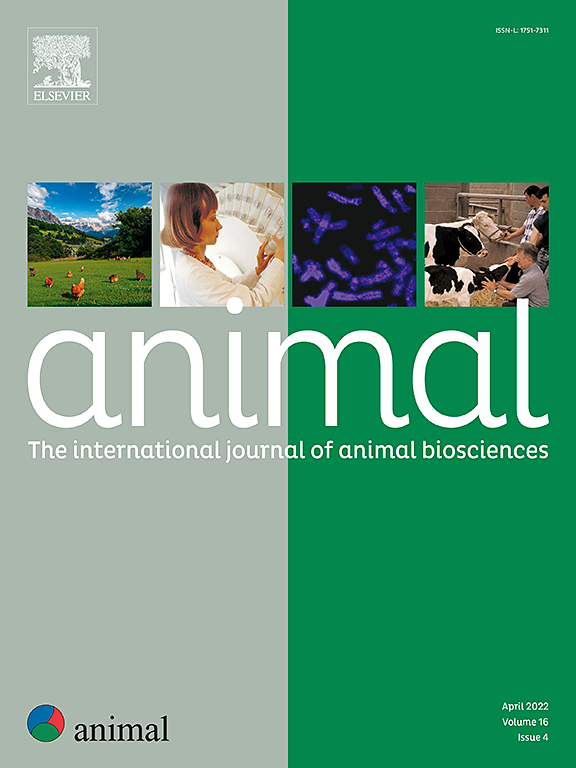选择分析的特征揭示了构成干腌火腿生产系统遗传骨干的三个重型猪种之间的基因组差异
IF 4.2
2区 农林科学
Q1 AGRICULTURE, DAIRY & ANIMAL SCIENCE
引用次数: 0
摘要
意大利养猪业的独特之处在于,它专注于饲养重型猪,主要用于生产优质干腌火腿。这些产品要求猪在 9 个月大时活重达到 170 公斤左右时屠宰。该系统使用的主要品种是意大利杜洛克猪、意大利陆地猪和意大利大白猪,通过杂交培育出符合标准要求的品系。在过去的四十年中,这些品种的选育计划受到了不同的选择压力,以突出每个品种的特点。在这项研究中,我们通过分析来自 9000 多头猪的高密度单核苷酸多态性数据,对这些品种的基因组进行了调查,并使用四种不同的方法(两种在品种内部,两种在不同品种之间)扫描选择特征。这有助于确定区分这些品种的基因组区域以及相关基因和生物术语。在全球范围内,我们发现意大利杜洛克猪种与意大利陆地猪种和意大利大白猪种的遗传分化程度较高,成对 FST 值为 0.20,而意大利陆地猪种和意大利大白猪种之间的成对 FST 值为 0.13。这可能反映了它们不同的起源或不同的育种目标,意大利兰德瑞种和意大利大白种的育种目标更为相似。尽管在整体水平上存在这些遗传差异,但很少有选择区域的特征达到完全固定,这可能是由于在检测与定量多基因性状相关的选择方面存在挑战。检测到的区域重叠程度较低,这证实了三个品种之间的差异。对三个品种进行的遗传富集分析发现了与生长和脂肪沉积有关的各种生产性状相关的途径和基因。这可能表明,虽然这三个品种的相同选择方向可能针对不同的生物机制,但它们都有一个共同的选择方向,即提高特定的生产性状。因此,这些基因可能在决定意大利杜洛克猪、意大利陆地猪和意大利大白猪的独特特征方面起着关键作用,并可能影响由它们衍生的杂交猪的性状。总之,本研究获得的见解将有助于了解定向选择是如何塑造这些重型猪种的基因组的,并有助于更好地制定旨在提高与干腌火腿生产链相关的肉类加工业的选择策略。本文章由计算机程序翻译,如有差异,请以英文原文为准。
Signatures of selection analyses reveal genomic differences among three heavy pig breeds that constitute the genetic backbone of a dry-cured ham production system
The Italian pig farming industry is unique in its focus on raising heavy pigs primarily for the production of high-quality dry-cured hams. These products require pigs to be slaughtered at a live weight of around 170 kg at 9 months of age. The primary breeds used in this system are Italian Duroc, Italian Landrace, and Italian Large White which are crossed to produce lines that meet standard requirements. Over the past four decades, selection and breeding programmes for these breeds have been subjected to distinct selective pressures to highlight the characteristics of each breed. In this study, we investigated the genome of these breeds by analysing high-density single nucleotide polymorphism data from over 9 000 pigs to scan for signatures of selection using four different methods, two within breeds and two across breeds. This allowed to identify the genomic regions that differentiate these breeds as well as any relevant genes and biological terms. On a global scale, we found that the Italian Duroc breed exhibited a higher genetic differentiation from the Italian Landrace and Italian Large White breeds, with a pairwise FST value of 0.20 compared with the 0.13 between Italian Landrace and Italian Large White. This may reflect either their different origins or the different breeding goals, which are more similar for the Italian Landrace and Italian Large White breeds. Despite these genetic differences at a global level, few signatures of selection regions reached complete fixation, possibly due to challenges in detecting selection linked to quantitative polygenic traits. The differences among the three breeds are confirmed by the low level of overlap in the regions detected. Genetic enrichment analyses of the three breeds revealed pathways and genes related to various productive traits associated with growth and fat deposition. This may indicate a common selection direction aimed at enhancing specific production traits, though different biological mechanisms are likely targeted by the same directional selection in these three breeds. Therefore, these genes may play a critical role in determining the distinctive characteristics of Italian Duroc, Italian Landrace, and Italian Large White, and potentially influence the traits in crossbred pigs derived from them. Overall, the insights gained from this study will contribute to understanding how directional selection has shaped the genome of these heavy pig breeds and to better address selection strategies aimed at enhancing the meat processing industry linked with dry-cured ham production chains.
求助全文
通过发布文献求助,成功后即可免费获取论文全文。
去求助
来源期刊

Animal
农林科学-奶制品与动物科学
CiteScore
7.50
自引率
2.80%
发文量
246
审稿时长
3 months
期刊介绍:
Editorial board
animal attracts the best research in animal biology and animal systems from across the spectrum of the agricultural, biomedical, and environmental sciences. It is the central element in an exciting collaboration between the British Society of Animal Science (BSAS), Institut National de la Recherche Agronomique (INRA) and the European Federation of Animal Science (EAAP) and represents a merging of three scientific journals: Animal Science; Animal Research; Reproduction, Nutrition, Development. animal publishes original cutting-edge research, ''hot'' topics and horizon-scanning reviews on animal-related aspects of the life sciences at the molecular, cellular, organ, whole animal and production system levels. The main subject areas include: breeding and genetics; nutrition; physiology and functional biology of systems; behaviour, health and welfare; farming systems, environmental impact and climate change; product quality, human health and well-being. Animal models and papers dealing with the integration of research between these topics and their impact on the environment and people are particularly welcome.
 求助内容:
求助内容: 应助结果提醒方式:
应助结果提醒方式:


